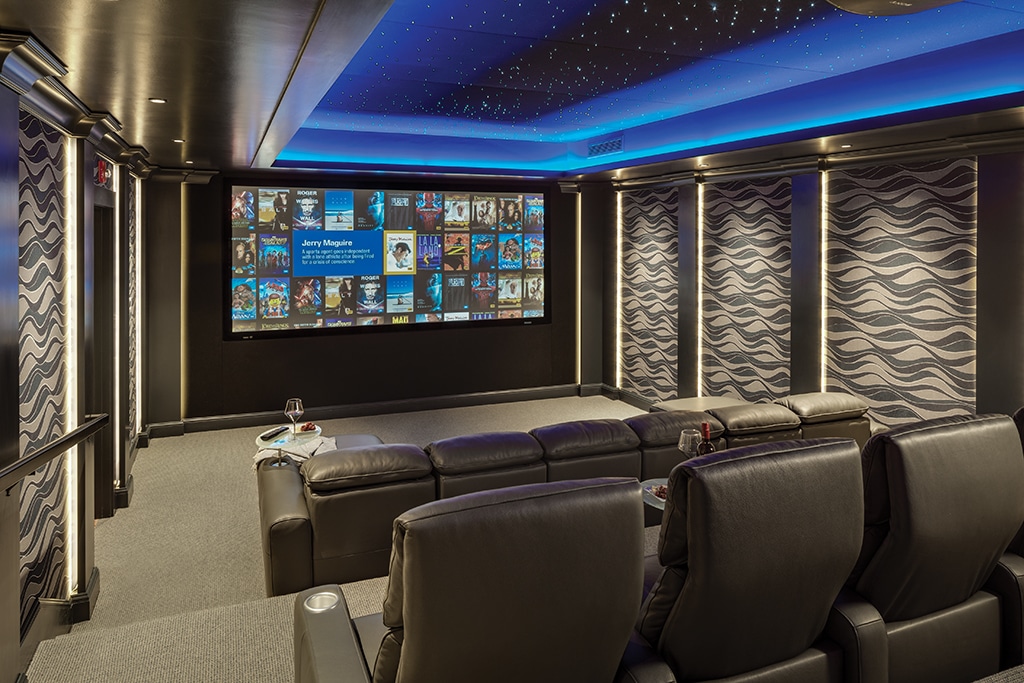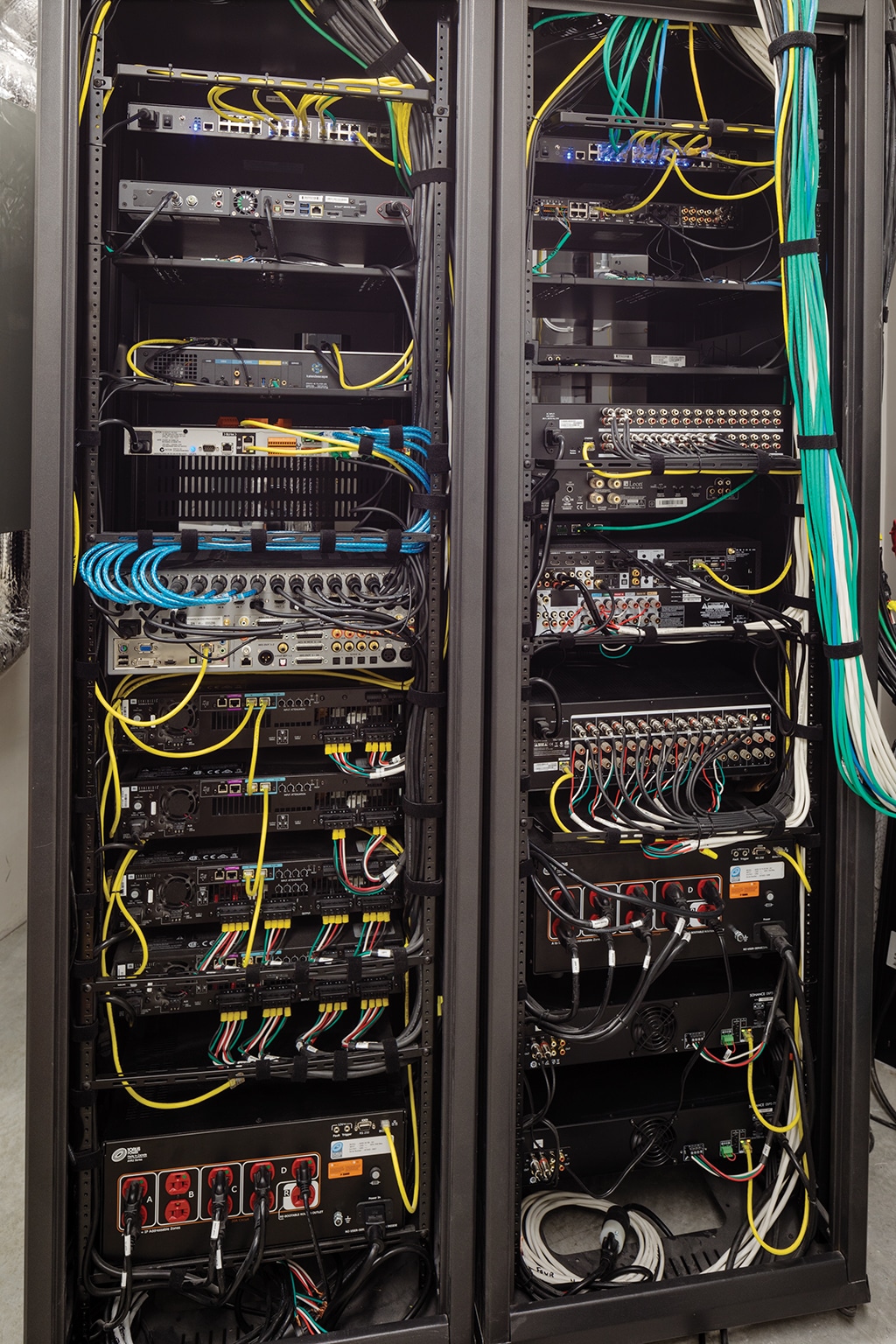
Showstopper
Cape Cod Home / Annual Home 2019 / Home, Garden & Design, People & Businesses
Writer: Mary Stanley / Photographer: Greg Premru
Showstopper

Cape Cod Home / Annual Home 2019 / Home, Garden & Design, People & Businesses
Writer: Mary Stanley / Photographer: Greg Premru

The 149-inch Stewart Cinemascope screen, LED-lit columns and color-changing cove lighting, and fiber optic ceiling help create an authentic movie theater experience.
AVD envisions a home theater of cinematic proportions
It is not unusual for homeowners to create a room or space in their house that is devoted to a specific hobby or interest—designed for no other reason than to feed their soul. Many times, these rooms become a sanctuary—a place to escape, rejuvenate, reflect or be entertained. Some homeowners have turned the basement of their home into a man cave of sorts, with sports-related paraphernalia adorning every wall and a television screen so large that viewers feel like they are sitting on the 50-yard line while watching football games. Others have chosen to build oversized garages to house their collection of antique and classic cars while also serving as a place to tinker. Cinema enthusiasts, on the other hand, prefer a space that provides an authentic theater experience while at the same time offers all the comforts one has come to expect when watching movies at home. Such is the case for one West Dennis homeowner, who transformed the lower level of a guest house on his riverside property into a state-of-the-art movie theater, complete with top-of-the-line acoustics and seating choices that could rival any commercial cinema.
From the LED lights in the floor’s risers to the fiber optic lighting in the ceiling to the acoustics that emanate throughout the 600-square-foot room, this design is a movie buff’s dream. Stadium-style seating that accommodates three rows of rich, beautiful leather incliners, including two chaise lounges, with the capacity to seat 16, as well as a nearby wet bar, offers family members and guests the ideal space for watching movies or playing on video game consoles.
An equally impressive part of this project is the choice of technology, which includes a JBL Synthesis system, which uses all of the latest formats along with a state-of-the-art Sony Laser Projector. This one-two punch of audio-video technology engulfs the viewer for a truly extraordinary cinematic experience.

A view from the front of the theater details the hand-stretched fabric panels and the high-quality European leather seating. Chaises in the front row allow for even cozier viewing and snuggling up with loved ones.
The project was a collaborative effort between Audio Video Design (AVD) of Osterville and Westwood, Encore Construction of Dennis Port, CinemaTech of Dallas, Texas, and Barbara Kotzen of Kotzen Interiors. While CinemaTech provided the seating designs and Kotzen chose the fabrics and soft materials in the space, AVD combined all of the audio and video technology used in this design onto one platform, a Control4 integration system, offering ease of operation so that whether family members are using a tablet, smart phone or controller, every setting is at their fingertips. AVD System Designer Kyle Tripp says this easy-to-use system is one of the elements that really sets this home theater apart from others, making it a winning design. Last year, the Home Builders & Remodelers Association of Cape Cod awarded the project a Silver BRICC Award for Use of Smart Technology, and the Builders and Remodelers Association of Greater Boston gave it a Gold PRISM Award for Smart Design.
As exciting as the audio and video systems are, one of the biggest wow factors in this room is the customized leather seating. Tripp says the homeowner chose all top-of-the-line products for this part of the design. ACT 1 incliners from CinemaTech, which are ergonomically designed to provide balanced support while watching movies, also feature headrests that adjust to provide customized support to maximize the quality of surround sound experiences. Glass tables that pop up from the armrests are a much more upscale version of yesterday’s metal tray tables.
Though the award-winning project is inspiring, it was not without its challenges. “Almost as soon as we got started, we ran into a few setbacks and we knew this was going to be a bigger project,” says Tripp. He says when the HVAC system was being installed, it affected the design of the theater, which required redesign of soffits, speaker placement, fiber optic lighting as well as the room’s mechanicals. From great challenges often come great opportunities, and that was the case here.

A glass of wine and a great movie—what better way to spend a night in?
By far, he says, one of the biggest challenges was isolating the room—ensuring that the sound and vibrations did not bleed into any other parts of the house. Thanks to “Star Wars” Director George Lucas, Tripp says, since the 1990s, surround sound has been an integral component of any audio-video experience, and it is especially important when building a home movie theater. But with such a sophisticated acoustical system comes the drawback of noise infiltrating other rooms of the home. While fabric-covered wall panels could offer one solution for containing sound, keeping it from emanating through the theater’s ceiling required some ingenuity.
At the recommendation of CinemaTech, the team turned to a company called Kinetics Noise Control, which specializes in acoustics for residential theaters and provides solutions for achieving sound control. Their solution was to create a so-called “floating ceiling.” Kinetics provided the materials so that Encore Construction could build it. “It’s a ceiling created on suspension. When acoustic pressure swells, the ceiling will push up and down slightly, to keep the sound from bleeding into the room above,” says Tripp.
The creation of this floating ceiling gave way to another wow factor in the room. Color changing lights built into the soffit along with fiber optic lighting gives the illusion of a starry night. With the push of a button, the movie theater almost achieves the illusion of a planetarium.
Though the space is devoted to movie watching, it easily accommodates other activities, including listening to music. “The room employs one of the most sophisticated sound systems and has speakers dedicated to various levels strategically placed around the room. It is the 3D of audio, and the space provides a better listening experience than quality CDs,” Tripp says.

Custom floor-standing racking solutions provide housing for electronics and necessary power conditioning equipment and temperature-controlled fans for the theater. Seen here is the rear of the racks with the removable doors temporarily removed.
An equally significant part of this design are the elements that are not seen but certainly lend themselves to the experience. Tucked behind beautiful fabric-covered panels are fiberglass panels that combine reflection and absorption characteristics, all of which contributes to sound containment. All of the essential technology needed to deliver the full cinematic experience is built in throughout, and equipment is easily accessible in a nearby electrical closet.
Tripp says this home theater design deviates a bit from the kind of work he typically does. He says today’s interior design trends have most homeowners trying to diminish the sight of the television and other audio-video equipment so that it does not dominate a room or become the main focus. “My work is usually focused on hiding the audio and video equipment,” he says. Over the past several decades, home entertainment centers have evolved, or devolved, from large screen projection televisions to less ominous equipment, such as large yet very thin-screen televisions strategically placed on a wall or over a fireplace mantle. “And even that trend is beginning to wane,” Tripp says. He notes his company does a lot of work with builders who hide projection screens in ceilings or furniture makers who can hide them in a table or credenza. “When the homeowner is not watching television, it retracts into the furniture. We’re seeing a lot of these in family rooms and especially in bedrooms,” Tripp says.
From the very beginning, Tripp says this homeowner, who is extremely enthusiastic about movies, was seeking a home cinema that would offer an authentic movie-going experience, and he certainly achieved that. “His goal for this project was to have an elevated home theater system,” Tripp says, “and this is the maximum in elevation. It is literally a cinema in a home.”



